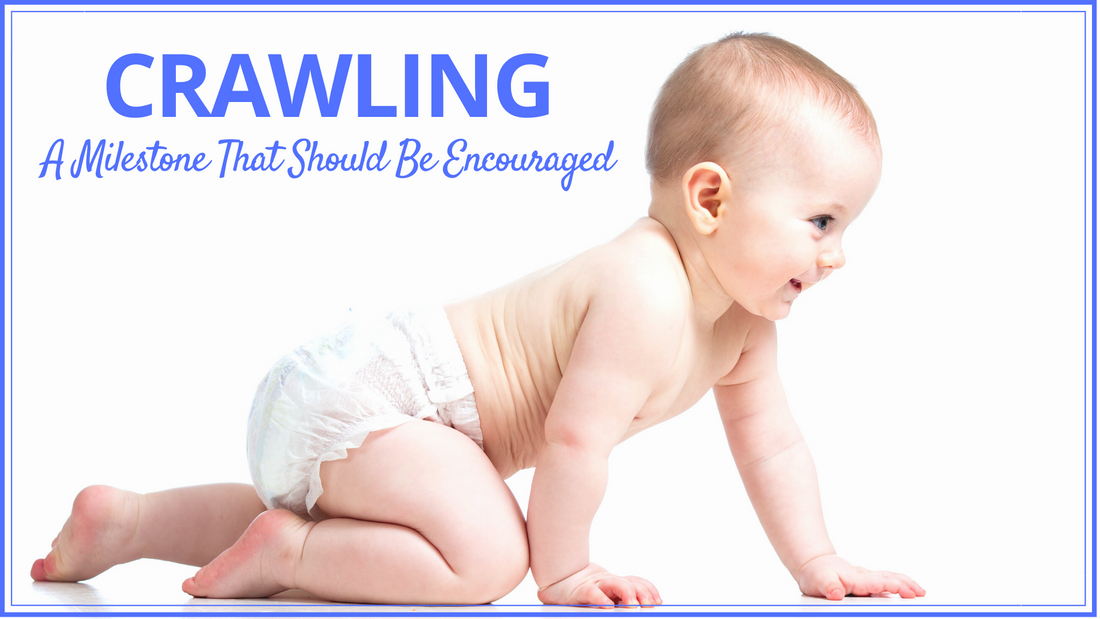
Crawling: A Milestone That Should Be Encouraged
1) Crawling builds the brain.
Both sides of the brain need practice working together. Our brains are separated into two halves, the left and right hemispheres, and are connected together by a neural “roadway” called the corpus callosum. As your baby crawls, his left leg moves in sync with his right arm. This reciprocal movement activates and coordinates both sides of the brain and helps to integrate some primitive reflexes that were needed earlier on but are no longer necessary. Using both arms in a coordinated way is termed bilateral coordination, and is necessary to button a shirt, climb a ladder, open a water bottle, and stabilize a piece of paper while writing.

2) Crawling increases strength.
In order the develop a proper pencil grasp, your child needs sufficient strength from the core to the shoulder and all the way down through the fingers. Crawling is the only stage which significantly strengthens the upper body in preparation for more advanced fine motor skills like coloring, cutting, and writing. Weight-bearing through the arms builds upper body strength from the shoulders all the way to the tiny muscles in the hand, developing the palmar arches so your child can effectively hold a pencil in elementary school.

3) Crawling improves vision.
By actively moving through his environment, your baby is developing more efficient binocular vision (coordination and use of both eyes). As he looks to find his favorite toy on the other side of the room, his eyes work as a team as he crawls on over, developing depth perception in a 3-dimensional world. Adequate binocular coordination is necessary to copy notes from a board, catch a ball, and go up and down stairs safely.

4) Crawling develops the sensory systems of touch and proprioception.
Crawling on different surfaces like carpet, tile, and even outside on the grass, helps to refine your baby’s tactile system (sense of touch). A refined tactile system greatly impacts both gross motor and fine motor coordination, allowing us to build, draw and paint. Weight-bearing during crawling also provides valuable proprioception, telling the brain where the body is in space, which is necessary to develop a good sense of body awareness to avoid tripping and bumping into obstacles.

What to do to help your baby achieve this step:
TUMMY TIME! Get your little one used to playing on his belly, which will help develop his core and upper body strength. Eventually, he will push up on his arms and begin to get his legs underneath his body. After rocking back and forth on his arms and legs, he’ll develop the courage and motivation to get a move on and explore his world!
Crawling around or over obstacles will help to improve his strength, balance, and motor planning abilities. Once he’s on the go, try placing your couch cushions on the floor for him to get his brain working and figuring out how to get to his destination. Toys like tunnels and balls also provide the motivation and curiosity to keep your baby moving.
What if my baby misses this stage of development?
Even if the crawling stage is missed, you can go back to it! This means that you can still encourage your toddler or preschooler to crawl during play. Creating obstacle courses, holding yoga poses, and even hanging from monkey bars are all ways you can help your child achieve similar benefits.
Bottom Line: Crawling is important for both brain and body development. It should be encouraged to help create connections within the brain, build strength for more advanced gross and fine motor skills, develop more advanced binocular vision and depth perception, and shape strong sensory systems.
-Maryann Deutsch, MS, OT/L & Dr. Allison Mell, PT, DPT

No comments







0 comments